Hello everybody, and welcome back to the second week of my Ravnica month, a month-long theme where I will be diving into each of trips to Ravnica to pull out a general befitting my own brand of deckbuilding. Last week I covered Niv-Mizzet, the Firemind, reflecting back on our first trip to Ravnica and what effect it had on me as somebody who had never experienced a block with such a high saturation of multicolored cards. This time around, my deck selection will not be so straightforward or built to turn your brain off and just slide through a game. Today, I will be talking to you about Teysa, Envoy of Ghosts and the political, sometimes strenuous style of gameplay that the Orzhov employ.
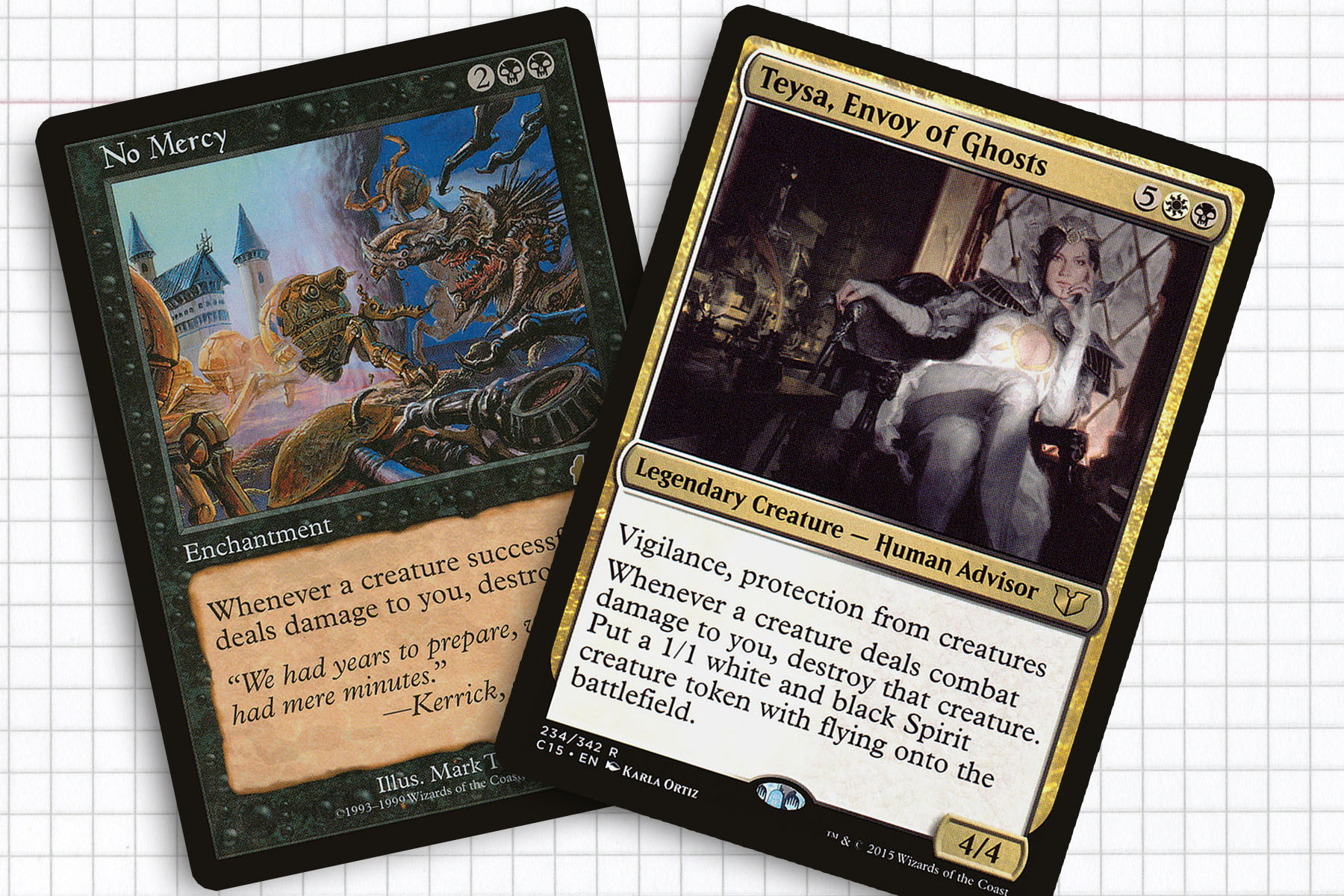
Blood, Sweat, and Debt
When we came back for Return to Ravnica the feel of the block was a little different—now structured in a such a way to capture five of the ten guilds in each set. The first two sets, Return to Ravnica and Gatecrash, were large sets; meaning that for the first time, the guilds in the sets could be drafts in their purest forms. This was an exciting and welcomed change, allowing for each guild to really get a sense of individuality, while also allowing the Limited formats of the time to have their own identities.
Just as Ravnica had changed, my life was different as well. I was no longer in high school—it would be embracing if I were—and I was living outside of my parents, balancing my finances between my hobbies and paying rent. To cut to the heart of the metaphor, the reason I’ve picked Teysa for today is because it is a reflection of the period of my life when Return to Ravnica block was released. The Orzhov employ a long-term political strategy and life had taken on similar qualities, as I had to learn who was trustworthy and who was looking to throw me under the nearest bus for their gains.
Teysa up to this point was a revered Orzhov lawmage and niece to a member of the Obzedat, Ghost Council. While she has never sported the guild mechanics, I feel that her first incarnation as Teysa, Orzhov Scion did more to support the surface level goals of Haunt by being a sacrifice outlet. Haunt may have been overly complicated, but Extort was easy to understand and sculpted games in such a way that small leads could be obtained with excess mana as the game stretched on. One of the ways to keep games going longer is to deter being attacked, which Teysa, Envoy of Ghosts does since she naturally has No Mercy attached.
This long-term political mindset is what I want to capture in my Teysa deck. I will not be playing completely within the lines of Orzhov, though; and I’m looking to bend the game in a different political sense, because we are playing Commander. I think if one guild gets the most out of the Conspiracy sets it might be Orzhov. When allowed to revel within a multiplayer format, Orzhov generally endures as it minimizes opponents’ options. That’s why I intend to bring in the voting politics of the Conspiracy sets along with some other smaller mechanics to help push my own agendas.
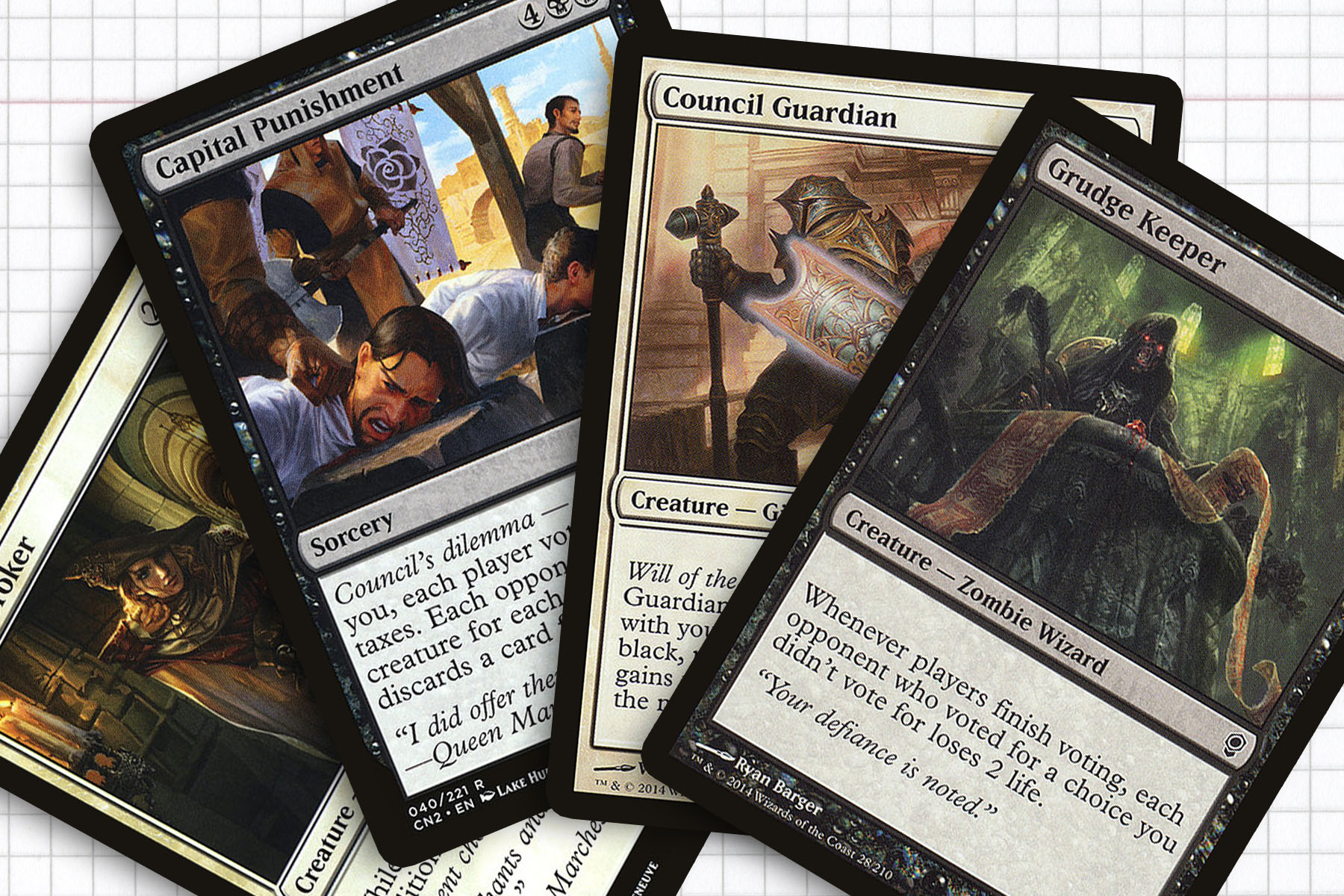
Rock the Vote
In a democracy every vote counts, the exception being the Orzhov, who might get two votes. While voting is admittedly a small theme within the deck, the ability to take advantage of the multiplayer setting and apply our own layer of politics pushes interaction, especially on a social level. White allows us to garner extra votes through Brago’s Representative and Ballot Broker pushing political aspects during the game in our favor.
The voting mechanic comes to us out of Conspiracy and Conspiracy: Take the Crown with Will of the Council and Council’s Dilemma respectively. In theory, by replacing our Vindicate with Council’s Judgment and our Syphon Flesh with Tyrant’s Choice and Capital Punishment we can change the way that our deck feels without necessarily getting rid of some of the core multiplayer effects we want. These themes extends to Council Guardian, Lieutenants of the Guard, and Grudge Keeper—creatures who have a long-lasting effects on the battlefield and player psychology, pushing the theme of choice for each player.
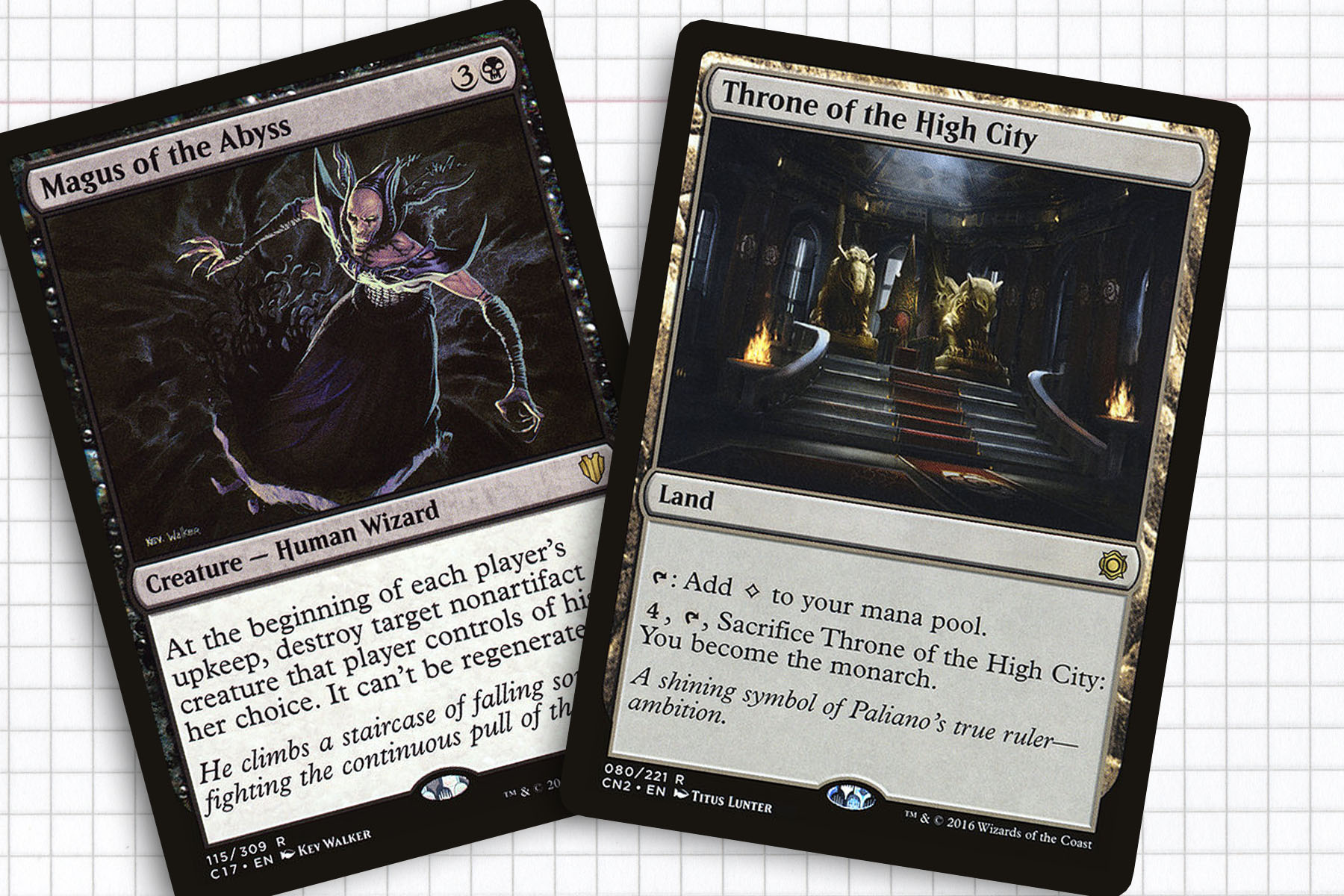
Snap Decisions
Dovetailing off the voting mechanic, this deck is going to strive to make opponents have to make decisions on a regular basis. And hopefully your opponent will exercise their option to turn their attention to another player. This is where card selection like Throne of the High City, Custodi Lich, and Thorn of the Black Rose can get the monarch mechanic into play, which one of my favorite methods of promoting player interaction. If we’re going to be the monarch, I want to have the constant question lingering in our opponents’ minds whether it is smart to attack us by employing cards beyond our general like No Mercy, Hissing Miasma, or Marchesa’s Decree.
Let’s drive this theme of choice home, making optimal moves not an option for the rest of the table. Archfiend of Depravity is a role-player in many decks that doesn’t get spotlighted often enough; here it will help to keep our opponents’ battlefields at a reasonable size that should make threatening our life total difficult. Comboing with the Archfiend is Fight or Flight, which will put players in a tough spot where they may struggle to get effective off alpha strikes. We can even do our best impression of a blue player by casting Evangelize so our opponents give us creatures.
Orzhov Advokist is also going to be an important card to consider, as it forces players to commit at the beginning of their turns on their intentions of combat for the turn. This is further pushed by the choices of the other players at the table, who may have chosen to size up their creatures, pushing the game to an arms race. Then, before anything gets aimed at you, you deploy a Wrath of God.
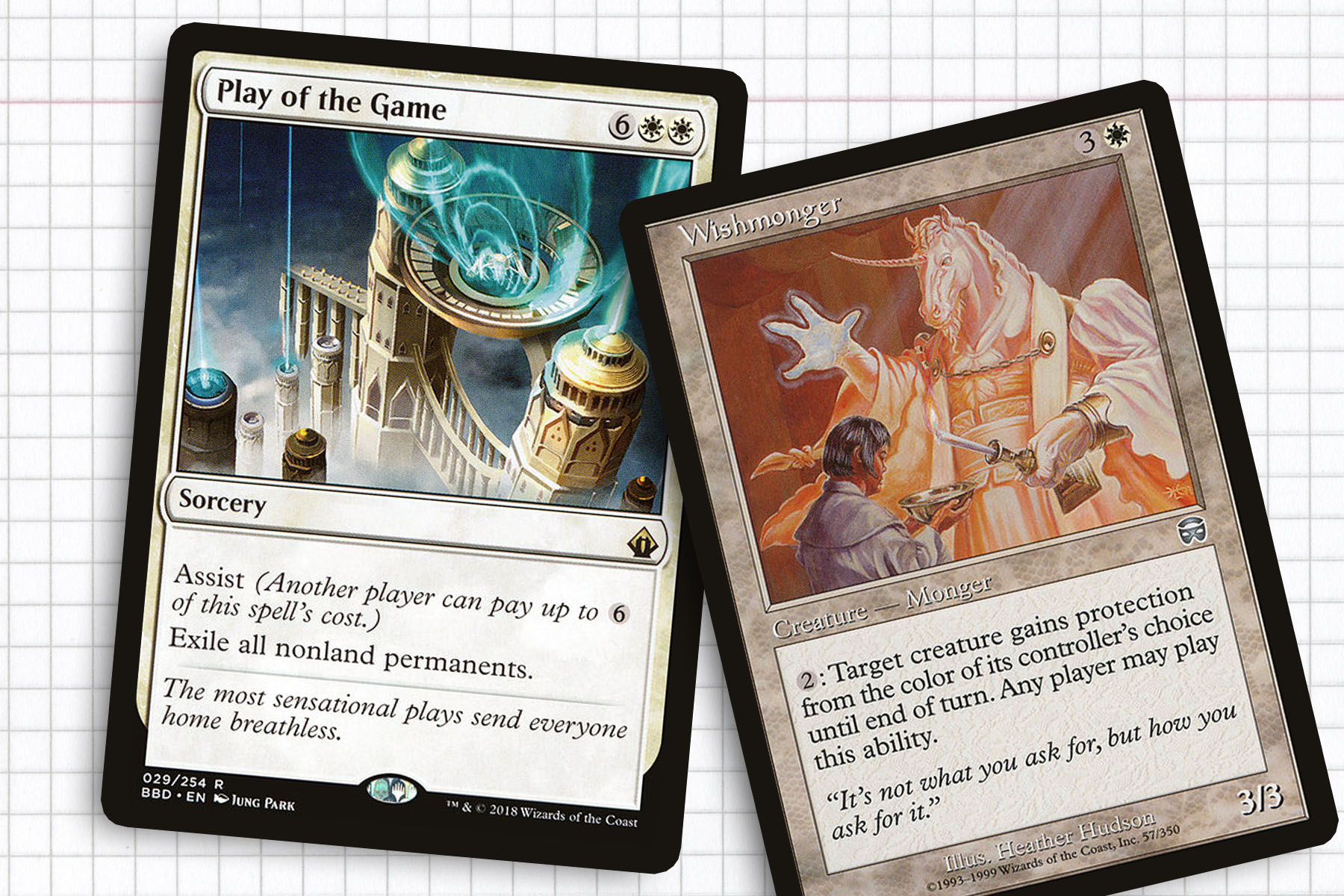
Enemy of My Enemy
Of course we don’t want to make enemies with everybody. Sometimes we need to take down the biggest threat at the table by forming alliances with other players. This is where the Battlebond mechanic, Assist, is going to be very helpful. With access to cards like Bring Down, Gang Up, and Play of the Game, we can keep pushing our agenda forward while using other people’s mana. I call this subtheme “making other people use up all their mana whenever possible.” The psychological catch being that players will see the group hug aspects you’re presenting and often leave you be until they think they have you beat.
The poster child of this strategy is probably Well of Knowledge, which can offer players a chance to overcome an empty hand at the cost of a delay in playing what they draw. My favorite duo for this strategy has to be Scandalmonger and Wishmonger, two admittedly bad cards that offer every player in the game contextually useful abilities at the cost of generic mana. The fun part being that it is reasonable that you become the last target of any of this malice by simply controlling when they are on the battlefield.
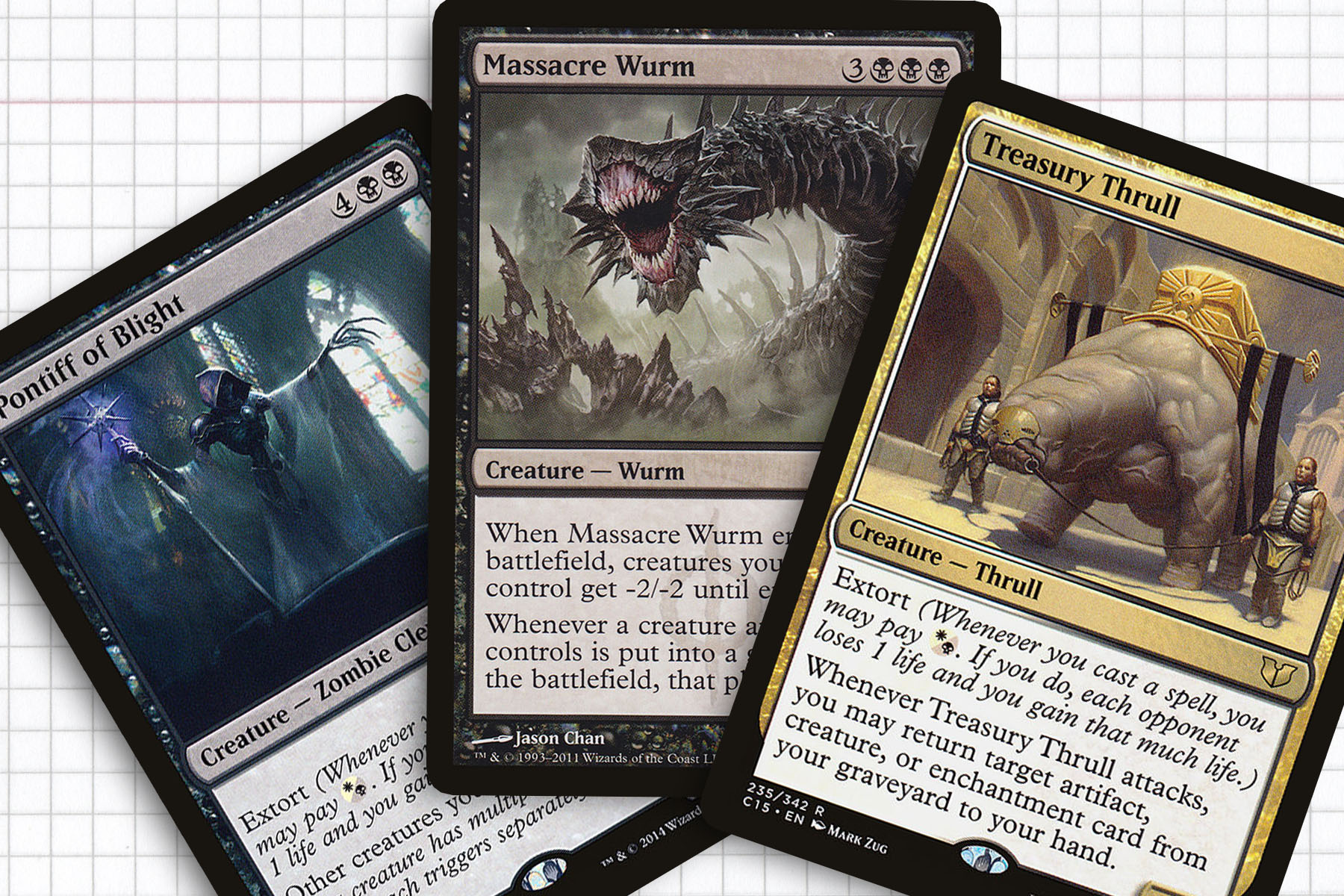
Debt Beyond Death
The last important factor of this deck ties in closely to the beliefs of The Orzhov Syndicate: debt follows you everywhere. Because we’re playing with black, we’re going to be able to reacquire a lot of the tools we might lose over the course of the game, including our life total through the Extort mechanic. Pontiff of Blight and Crypt Ghast are the two most popular cards to sport Extort, but Treasury Thrull deserves some attention here, as it acts as a second copy of Sun Titan for this deck.
Creatures are going to be our most fruitful card type to recoup; so Palace Siege, Athreos, God of Passage, Debtors’ Knell, and Ravos, Soultender can go a long way if we happen to be employing creatures like Teysa, Orzhov Scion, Grave Titan, or Skeletal Vampire for their token-producing abilities. Additionally, the suite of Fleshbag Marauder, Merciless Executioner, and Sheoldred, Whispering One will help suppress opponents’ boards. For board wipes with bodies, Massacre Wurm and Demon of Dark Schemes are seasoned professionals.
With hindsight I’ve come to like Return to Ravnica block, but I will admit that at the time I didn’t really care for it. I think some of that comes from an underwhelming feeling—the first trip was so groundbreaking and the second just could not live up to that. That’s the important part about revisiting topics from time to time. I’m not sure how Guilds of Ravnica and Ravnica Allegiance will fare as I look back in another six years.
Join me next week as we move forward six years to the present, 2018. I’ll be tackling a general from Guilds of Ravnica and trying to forecast just what might be the highlights of the pseudo-block thus far. Thanks all.
Ryan Sainio is a Graphic Designer who writes about EDH, the EDH community, and streams on Twitch in his down time. He has been playing Magic: The Gathering since 7th Edition in 2002 and values flavorful and fun gameplay over competitively optimized decks. Join him for a stream at twitch.tv/hipstersainio on Tuesday nights.

